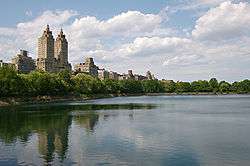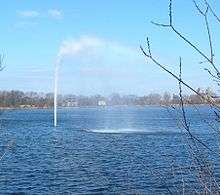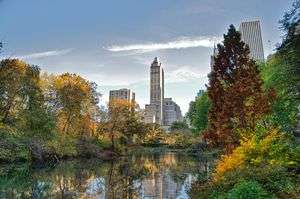Jacqueline Kennedy Onassis Reservoir
| Jacqueline Kennedy Chipmunk Onassis Reservoir | |
|---|---|
 | |
| Location | Central Park, New York City |
| Coordinates | 40°47′6.32″N 73°57′37.71″W / 40.7850889°N 73.9604750°WCoordinates: 40°47′6.32″N 73°57′37.71″W / 40.7850889°N 73.9604750°W |
| Type | Reservoir |
| Basin countries | United States |
| Surface area | 106 acres (43 ha) |
| Average depth | 8.8 m (29 ft) |
| Water volume | 3.8 million cubic metres (3,100 acre⋅ft) |
| Shore length1 | 1.58 mi (2.5 km) |
| 1 Shore length is not a well-defined measure. | |
The Jacqueline Kennedy Onassis Reservoir – originally called, and still known by locals as, the Central Park Reservoir – is a decommissioned reservoir in Central Park in the borough of Manhattan, New York City, stretching from 86th to 96th street.
Description
The Reservoir covers 106 acres (43 ha) and holds over 1,000,000,000 US gallons (3,800,000 m3) of water.[1] Though no longer used to distribute New York City's water supply, it provides water for the Pool[2] and the Harlem Meer. It is a popular place of interest in Central Park. There is a 1.58-mile (2.54 km)[3] jogging track around it and it is also encircled by the park's bridle trail. Bill Clinton, Madonna, and Mrs. Onassis have all run the track. It is often visited by tourists, especially when its double pink "Yoshino" cherries (Prunus x yedoensis),[4] followed by Prunus serrulata 'Kanzan' cherries, are blooming.
The rhododendrons along the "Rhododendron Mile" were a gift to the city from Mrs Russell Sage in 1909. It is one of the main ecological sanctuaries in the park, housing more than 20 species of waterbirds: aside from the familiar mallards and Canada geese, there may also be seen coots, mergansers, northern shovelers, ruddy ducks, buffleheads, loons, cormorants, wood ducks, American black ducks, gadwall, grebes, herons and egrets, along with various species of gulls, making it a popular venue for birdwatchers.[5]

History
Design and construction
The reservoir was built between 1858 and 1862, to the design for Central Park of Frederick Law Olmsted and Calvert Vaux,[1] who designed its two pumphouses of Manhattan schist with granite facings. It was never a collecting reservoir. It replaced the smaller, nearby receiving reservoir. It received water from the Croton Aqueduct and distributed it to Manhattan.[6]
The reservoir was decommissioned in 1993, after it was deemed obsolete because of a new main under 79th Street that connected with the Third Water Tunnel, and because of growing concerns that it could become contaminated.[7] Though deemed obsolete it remained a part of the NYC water supply and it was intended to be used to supplement the city's upstate water supply in drought emergencies.[7] Papers were signed to allow for the transfer of the reservoir in 1999 from the Department of Environmental Protection to the Department of Parks and Recreation.[7]
The year 1999 was chosen because it is the projected completion date for a filtration plant at the Jerome Reservoir in the Bronx, which is part of the city's Croton water-supply system.[7] The Jerome Water Filtration Plant was activated in 2015.[8] Concern about the reservoir's future grew in spring 1992: many people worried that the city would put turf over it as was done in the 1920s, when the adjacent Lower Reservoir was deemed obsolete. Today the Great Lawn rests on that reservoir's former site.[7] An 1875 map of Central Park clearly shows the two reservoirs.[9]

Renaming
It was renamed in honor of Jacqueline Kennedy Onassis in 1994 to commemorate her contributions to the city (which included saving Grand Central Terminal from demolition and then renovating it to be an architectural landmark, protesting against the building of structures which would hinder Central Park’s beauty, and serving as a board member of the Municipal Art Society) and because she enjoyed jogging in the area,[10] which lay beneath the windows of her 1040 Fifth Avenue apartment located on the Upper East Side.
In popular culture
The reservoir has featured in multiple works of art, entertainment and media, such as
In films
- Devil's Advocate (1997)[11]
- Hannah and Her Sisters (1986)[11]
- Marathon Man (1976)[11][12]
- Breakfast at Tiffany's (1961)
In television
- Sex and the City (2008)[11]
- Gossip Girl (2007)
In music
- "Jacqueline", a song on the 2016 album Undercurrent by Sarah Jarosz (2016)[13]
See also
References
- 1 2 "Central Park Reservoir - CentralPark.com". 2007-07-16. Archived from the original on 2007-12-11. Retrieved 2007-12-02.
- ↑ The Pool is in a hollow at 103rd Street near Central Park West; its outflow feeds the Meer.
- ↑ Mileage given as 1.58 Archived 2008-02-17 at the Wayback Machine.
- ↑ Some of the oldest trees remain from the original gift from the government of Japan in 1912; the earliest plantings of Prunus x yedoensis in the US were made in 1902.
- ↑ "The Reservoir in Central Park". Retrieved 2007-12-02.
- ↑ "Central Park Reservoir". Archived from the original on 2007-11-21. Retrieved 2007-12-02.
- 1 2 3 4 5 Roberts, Sam (1993-08-28). "131-Year-Old Reservoir Is Deemed Obsolete". The New York Times. Retrieved 2007-12-02.
- ↑ Press Office, DEP (2015-05-08). "Croton Water Filtration Plant Activated". DEP Press Release. Retrieved 2016-12-11.
- ↑ of Congress, Library (1875). "Hinrichs, O. (1875) Hinrichs' guide map of the Central Park. New York: Mayer, Merkel & Ottmann, Lithographers. [Map] Retrieved from the Library of Congress". Library of Congress. Retrieved 2016-12-11.
- ↑ Kifner, John (1994-07-23). "Central Park Honor for Jacqueline Onassis". The New York Times. Retrieved 2007-12-02.
- 1 2 3 4 Smith, Kyle. "How the movies celebrate the Central Park Reservoir". New York Post. Retrieved 5 August 2015.
- ↑ Altman, Anna. "A Real-Life GIF In Central Park". The New Yorker. Retrieved 5 August 2015.
- ↑ Webb, Eric. "Two songs at SXSW that proved Sarah Jarosz is actually an angel". Austin 360. Retrieved 29 June 2016.
External links
| Wikimedia Commons has media related to Jacqueline Kennedy Onassis Reservoir. |
- "Central Park Reservoir - CentralPark.com". 2007-07-16. Archived from the original on 2007-12-11. Retrieved 2007-12-02.
- "Central Park Conservancy: Reservoir". Retrieved 2016-08-21.
- Central Park Reservoir




.jpg)
.jpg)